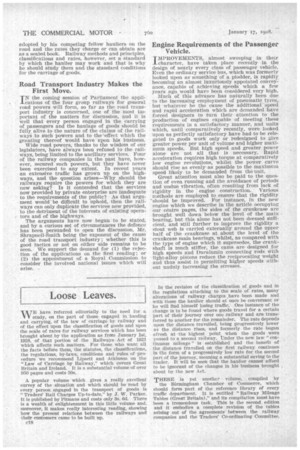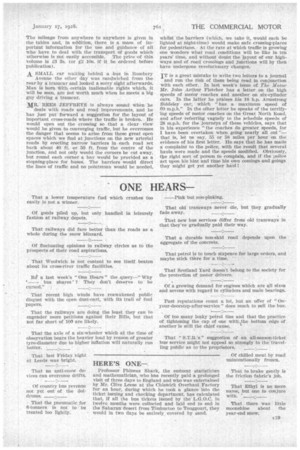Loose Leaves.
Page 40

Page 41

If you've noticed an error in this article please click here to report it so we can fix it.
WE have referred editorially to the need for a study, on the part of those engaged in hauling and carrying, of the law of earriage by railway and of the effect upon the classification of goods and upon the scale of rates for railway services which has been brought about by the application as from January 1st, 1928, of that portion of the Railways Act of 1921 which affects such matters. For those who want all the facts before them, the statutes, the classifications, the regulations, by-laws, conditions and rules of procedure we recommend Lipsett and Atkinson on the "Law of Carriage by Railway," which covers Great Britain and Ireland. It is a substantial volume of over 950 pages and costs 50s.
A popular volume which gives a really excellent survey of the situation and which should be read by every person engaged in the transport of goods is "Traders' Rail Charges Up-to-date," by J. W. Parker. It is published by Pitmans and costs only 3s. 6d. There is a wealth of enlightenment in this little volume and, moreover, it makes really interesting reading, showing how the present relations between the railways and their customers came to be built up.
c18 In the revision of the classification of goods and in the regulations attaching to the scale of rates, many alterations of railway charges have been made and with these the haulier should at once be conversant or he will find himself losing traffic. One instance of the change is to be found where goods travel for a certain part of their journey over one railway and are transferred to another for the remainder. The rate depends upon the distance travelled, being progressively lower as the distance rises, and formerly the rate began afresh at the highest point when the goods were passed to a second railway. tnder the new law "continuous mileage" is established and the benefit of the distance travelled on the first railway continues in the form of a progressively low rate for the second part of the journey, meaning a substantial saving to the trader. It will be seen that the haulier cannot afford to be ignorant of the changes in his business brought about by the new Act.
THERE is yet another volume, compiled by
the Birmingham Chamber of Commerce, which should form part of the reference library of every traffic department. It is entitled "Railway Mileage Tables (Great Britain)," and its compilation must have been a tremendous task. This is the second edition and it embodies a complete revision of the tables arising out of the agreements between the railway companies and the Traders' Co-ordinating Committee. The mileage from anywhere to anywhere. is given in the tables and, in addition,, there is a mass of important information for the use and guidance of all who have .to deal with the transport of goods which otherwise is not easily accessible. The price -of this volume is f3 3s. for £2 10s. if it be ordered before publication).
A SMALL car waiting behind a bus in Rosebery Avenue the other day was sandwiched from the rear by a tramcar and looked a sorry sight afterwards. Man is born With .certain inalienable rights which, it will be seen, are not worth much when he meets. a big guy driving a tramcar.
• MR. REES JEFFREYS is always sound when he
deals with roads and road improvements, and Ile has just put forward a suggestion for the layout of important cross-roads where the traffic is broken. HQ would open out the crossing so that a clearview would be given to converging traffic, but he overcomes the danger that seems to arise from these great open spaces which we find at junctions on the new arterial roads by erecting narrow barriers in each road set back about 40 ft. or 50 ft. from the centre of the junction, and not only would the corners be cut away, but round each corner a bay would be provided as a stopping-place for buses. The barriers would direct the lines of traffic and no pointsman would be needed,
whilst the barriers (which, we take it, would each be lighted at night-time) would make safe crossing-places for pedestrians. At the rate at which traffic is growing one wonders what road conditions will be like in ten years' time, and without' doubt the layout of our highways and of road crosSings and junctions will by then have undergone revolutionary changes.
IT is a great mistake to write two letters to a journal and run the risk of them a being read in conjunction with each other. In last week's issue of The Motor Mr. John Arthur Fletcher has a letter on the high speeds of motor coaches and another on six-cylinder cars. in the latter he praises his 18 h.p. Armstrong Siddeley car, which "has a maximum speed of 60 m.p.h." In the other letter he speaks of the terrify-Ing speeds of motor coaches on the Great North Road, and after referring vaguely to the schedule speeds of 28 m.p.h. for the journeys of these 'vehicles, says that in his experience "the coaches do greater speeds, for I have been overtaken when going nearly all out "— that is, let us say, 55 or 58 miles per hour on the evidence of his first letter. He, says that he has made a complaint to the police, with the result that several hauls were made and the speeds modified. Obviously, the right sort of person to complain, and if the police act upon his hint and time his own comings and goings they might get yet another haul!












































































































